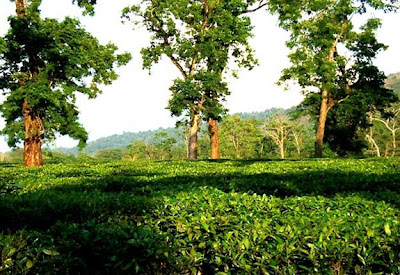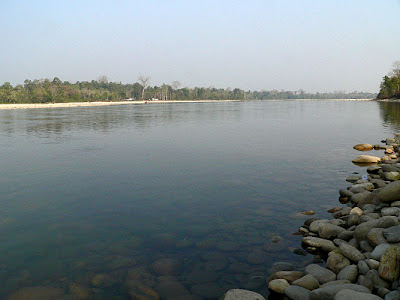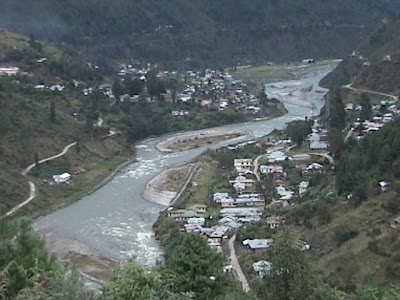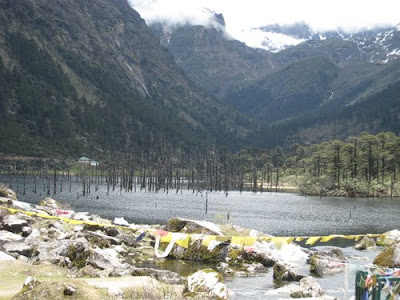Arunachal Pradesh, the land of rising sun, is a complete paradise full of lush green forests, thousands of species of flora and fauna, having its own traditional arts and crafts, and simple, friendly and hospitable people. This land with the sparse population is away from all commercialization, have very few tourists, so untouched; but mark my words, it’s worth visiting, a unique experience in itself. One feels so close to nature, away from all that hustle-bustle of daily life routine.
Arunachal Pradesh is a state of India, located in the far northeast. It borders the states of Assam and Nagaland to the south, and shares international borders with Burma in the east, Bhutan in the west, and the People's Republic of China in the north. The majority of the territory is claimed by the People's Republic of China as part of South Tibet. Its best to travel Arunachal Pradesh through Assam.
Assam is the land upon which Mother Nature has showered her blessings to the fullest. The gateway to the north eastern part of the country, the state of Assam is gifted with lush green meadows, fertile plains, the enormous Brahmaputra river, the beautiful hills, the blue mountains, the wonderful looking tea plantations, the rich flora and fauna. It is also the home to the famed one horned rhinoceros and few other rare animal species. Thus along with the tourists, it has also emerged as the favorite destination for the wild life lovers. Assam is best known for its National Parks.
Assam's popular National Park
Arunachal Pradesh being a Protected Area, tourists are required to get an Inner Line Permit ( ILP )/ Protected Area Permit. A number of entry formalities have been relaxed for foreign tourists. The permits can be obtained in following ways: I. For domestic tourists Innerline Permits are issued by the Secretary (Political),Government of Arunachal Pradesh, Itanagar and respective Deputy Commissioner and Additional Deputy Commissioner of the Districts. These can also be obtained from Resident Commissioner's office/ Liaison Offices located at New Delhi, Calcutta, Guwahati, Shillong, Dibrugarh, Tezpur, North Lakhimpur, Jorhat. II. For foreign tourists The foreign tourists can obtain the Protected Area Permit from all Indian Missions abroad, Home Ministry, Govt. of India and Home Commissioners, Govt. of Arunachal Pradesh, Itanagar. For more info refer to: |
How to reach: One cannot directly reach Arunachal Pradesh. Guwahati is the gateway to the whole of northeast India. So, to reach any part of Arunachal you have to reach Guwahati first.
Though there are various tourist circuits that can be followed to travel in Arunachal, the most picturesque and recommended path is the one you follow from Guwahati to Bhalukpong to Tawang.
Travel modes:
Click on the map to get larger view
Travel modes:
By bus: Arunachal State Transport Department is running daily services including deluxe night buses from Itanagar to most district head quarters including Guwahati/Tezpur in Assam and Shillong in Meghalaya. Private bus services are also available in different routes including private luxury buses operating from Guwahati to major cities of Arunachal. Taxis are also available throughout the state for various places.
By train: There is no railway station in the state so far due to tough hilly terrain but in the foot hills of Assam people can reach various destinations through nearby rail heads.
The nearest rail head for various places –
PLACE | RAIL HEAD (Assam) |
Itanagar Bomdila/Tawang | Harmuty Rangapara |
By air: Air services are available from Delhi, Kolkata to Guwahati and Mohanbari (Dibrugarh). One can directly reach Tawang from Guwahati by helicopter.
Advantages:
§ You reach fast , say, within an hour or so.
Disadvantages:
§ You miss all the scenic beauty and the adventurous trip.
§ Travelling by helicopter to Tawang is not safe at all. Helicopter crashes are common there.
Best way to travel: Hire a cab from Guwahati to Tawang for to and fro journey. Cab hiring charges are around Rs.25000 for total journey (for 7-8 days). Its recommended that you travel in a group and take out a minimum of 7-8 days for this journey.
Climate: Cooler than the rest of the North-eastern states on account of its altitude, evenings and mornings in Arunachal can get very cold. Areas that are at a very high elevation in the Upper Himalayas close to the Tibetan border enjoy an alpine or Tundra climate. Below the Upper Himalayas are the Middle Himalayas, where people experience a temperate climate. Areas at the sub-Himalayan and sea-level elevation generally experience humid, sub-tropical climate with hot summers and mild winters. Arunachal Pradesh receives heavy rainfall of 80 to 160 inches (2,000 to 4,100 mm) annually, most of it between May and September.
Best time to travel: October – November and April - May, specially if you are planning on visiting Bomdila or Tawang.
Worst time to travel: June – September, when the rains really come down hard and roads get washed away with communications getting disrupted and December – March, when it snows.
Things required: Warm woollen clothes, mosquito repellent, candle and match-box (since there’s frequent power failure throughout Arunachal Pradesh and also in Assam).
Health tips: Unlike Leh - Ladakh, Arunachal Pradesh has no lack of oxygen due to dense forests so there are less chances of getting AMS (altitude sickness). Heart patients get advised from your doctor. There are army camps at short distances throughout so there’s not much worry about medical aid if needed.
Though Assam and Arunachal Pradesh are sensitive areas yet tourists can freely enjoy the place , there not much safety concerns here. There are several army camps at short distances, specially in Arunachal Pradesh.
Iternary:
Tezpur-Bhalukpong-Bomdila-Tawang Tourist Circuit
Guwahati – Nameri National Park (Assam) (216 kms.):
Start your journey from Guwahati at early morning. From Guwahati take hired cab to Nameri National Park (N.P.). Its around 6-7 hours drive. Stop at Tezpur (181 kms. drive from Guwahati) for a lunch break. There are many restaurants at Tezpur. From Tezpur move on to Nameri National Park where you’d reach by evening. Nameri National Park has Eco Camp inside , surrounded by dense forest. Camp has individual eco-friendly huts with attached bathrooms. Camp offers you an excellent buffet for breakfast, lunch and dinner.
Though there’s not much to see at Nameri N.P. except for the Jia Bharali river that divides the dense forests into two parts and one can go for mild river rafting, nature walk, angling and bird watching. Beyond the river one can always hear the roars of tigers, trumpeting of elephants and chirping of various variety of birds. It is the home of mammals like Elephant, Tiger, leopard, Sambar, Barking deer, Hog Deer, Wild Boar, Gaur, slow loris, gaplangur, Burmese ferret badger, and over 350 species of birds including White-winged Wood Duck, Ibisbill (uncommon), Ruddy Kingfisher, Palla’s fishing eagle, Lesser Adjutant stork , Greater spotted eagle, Rufous necked hornbill, Great pied Indian hornbill, Wreathed hornbill, Long-billed Ringed Plover, Sultan Tit, and Yellow-bellied and White-throated Fantails. One night stay is sufficient here.
Next day morning one can start for Arunachal Pradesh and the stoppage would be Dirang.
Nameri National Park – Dirang (Arunachal Pradesh) (200 kms.):
Start early in the morning from Nameri so that you can reach Dirang before dark. From Nameri you head for Bhalukpong (28 kms. from N.P.) which is at the border of Assam and Arunachal Pradesh , in other words, it is the entry point to Arunachal Pradesh. At Bhalukpong you need to show the entry passes/permissions. There’s army canteen where one can take rest for a while and have some snacks. Also there are small shops where you can find eatables.
Then head for Bomdilla (125 kms. from N.P.) where you can stop at some restaurant for lunch. One can also stay at Bomdila. Bomdilla is at an altitude over 8500 feet, its colder and is famous for its Yak Research Center and orchids plantation and also apple and kiwi orchards. Apples and kiwis are produced in winters, so no apples and kiwis are available during summers. After quick lunch, start for Dirang.
Dirang is a valley-based town and one can find many hotels and lodges. Government lodges are also available and are better than other private ones. Also the meals available are better here. Mark, availability of proper north-Indian food is scarce except for the army canteens, so it’s advised you take your food items along with you or eat where-ever you find a proper hygienic place to eat. Due to sparingly any tourism and also less population there are only one or two star rated eating places.
Dirang
Dirang – Tawang (143 kms.):
After a night’s stay at Dirang, start for Tawang. Its again a long journey, say around eight to nine hours drive. Scenic beauty throughout the journey is mesmerising. On the way you’d find army canteen where you can stop for lunch / snacks.
The narrow roads, floating clouds , lush green dense forests of mixes vegetation – starting from deciduous forests to tropical rain forests to coniferous forests to mosses and lichens, the huge Himalayas and river flowing throughout the way in the valley and small and huge water-falls here and there , make your journey an unforgettable one and be with you as one of the most cherished memories. Its an experience in itself , worth all that that takes you to come here.
Sela Pass (about 13,900 feet above ground level): Sela Pass comes in the way to your journey to Tawang. This pass is the world’s second highest motorable pass after the one at Ladakh. It’s a unique experience in itself. This pass is basically the enterance to Tawang. A small dhabha which is kept hot and cosy, could be found here where one can eat Maggie and have some snacks along with a hot cup of tea. Also hot water for drinking is available. Run by an Arunachali couple, its such a relief in the bitter cold one faces there. There’s the half frozen Paradise Lake, surrounded by mountains , a beautiful sight in itself.
Jaswant Garh: The war memorial is located 14 kms from Sella Pass on the way to Tawang. The memorial pay homage to Jaswant Singh Rawat, Mahavir Chakra Awardee posthumous (the second highest award from the Indian Army). In the famous battle of Nuranang against Chinese in November 1962, Rawat and two other soldiers from 4th Batallion Garhwal Rifles were instrumental in killing 300 Chinese soldiers in 72 hours.
Tawang: You reach Tawang by evening and try to stay in a government lodge. Its almost like a three-star hotel and it is recommended to have your meals at the lodge itself since after much of “investigation” we came to this conclusion that while in Tawang, either eat in the army canteen or in the government lodge.
Jaswant Garh Fort
Magestic waterfall and power house on the way to Tawang
Places to visit in Tawang:
§ Tawang Monestry: It is the one of the world’s oldest and largest monestry , around 400 years old. It is situated at an altitude of approximately 10,000 ft. It also holds the distinction of being the birthplace of the 6th Dalai Lama. The monastery is the house of more than 700 monks. The monastery was founded by Merag Lama Lodre Gyamtso, in 1681 in accordance to the wishes of the 5th Dalai Lama, Nagwang Lobsang Gyatso. As per the legend, the site of the Monastery was chosen by the horse of Merag Lama. Merag Lama, who had been unable to decide a site to establish the monastery. One day he was praying in cave, seeking a divine guidance. When he came out after the prayers, he found his horse was missing. On search, the horse was located standing quietly on a hilltop. Considering that as the sign of divine blessing he decided to construct the monastery at the very spot. The monastery is also called Galden Namgey Lhatse meaning celestial paradise. There is a magnificent 8 meter high statue of Lord Buddha. The ancient library inside the courtyard has an excellent collection of thangkas, painted with the blood from the nose of 5th Dalai Lamaand valuable Buddhist manuscripts mainly Kanjur and Tanjur numbering 850 bundles.
Paintings @ Tawang Monestry
Offering "butter lamps" : the Monastic ritual @ Tawang Monestry
§ Tawang War – memorial: The memorial is dedicated to the martyrs of the 1962 Sino-Indian war. The memorial is 40-foot-high and like a stupa in design. It is locally called ‘Namgyal Chortan’. The names of 2420 martyrs imprinted in gold on 32 black granite plagues.
§ Ugyenling Monastery: It is the birthplace of the 6th Dalai Lama who is the only Indian to have risen to such a high position in Gelupka Sect of Buddhism so far. Inside the monastery there are several Stupas (Vihar) and people from all walks of life visit this place during Buddhist new year to get the blessing for the coming year.
Inscription @ Ugyenling Monestry
§ The Craft Center: The craft center in Tawang sells beautiful masks, hand woven carpets, jewellery in silver, coral and amber, ‘chubas’ the local dressand delightful affordable mementos.
Note: For the below destinations, permit has to be taken from DC office in Tawang. Get the permit stamped at the Brigade Major's office opposite Tawang War Memorial, the office is open to civilians after 5 PM. Without the Army stamp, you will not be allowed to ride on this inner line route.
Start early from Tawang; 7 AM is a good time, and start the return journey from Bum-la latest by 11.30 or noon, weather changes drastically at noon; clouds move in and visibility is very low, chances of snowfall are also high.
Wear ankle-high waterproof shoes, good pair of gloves, balaclava and ear protection. Make sure you protect the camera equipment. Exposing camera to extreme temperatures within a short span of time will result in condensation on recording heads/CCD.
§ P.T.TSo Lake (17kms from Tawang): It’s a beautiful lake at an altitude of 13000 feet , surrounded by snow-covered mountains , with crystal – clear water.
Bunkers on the way to PT Tso Lake
(used during 1962 Indo-China war)
§ Sungester Lake: Popularly known as Madhuri Lake (after the movie shooting of Koyla done here) is located 35 kms. away from Tawang near the China Border. The drive to Sungester Lake is full of thrill and one can still see the war bunkers that had been used during the Chinses aggression in 1962 and the beautiful P-TSo lake.
§ Bum-La Pass / Indo-China Border (altitude: 15000 feet): If the routes are clear and there’s no snow one can go watch the Indo-China border. The flags of two countries are placed 10 feet from one another and the small strip of land in between is "No Man's Land”. Usually "No man's Land" is more than a kilometer wide on International Border, but with China still claiming 90,000 sq Kms of India it occupied for two months in 1962, technically speaking, one finds himself at the Actual Line of Control on a disputed territory.
Indo - China Border
Tawang - Kaziranga National Park (Assam) (around 400 kms.): A two days stay at Tawang is sufficient and then you can return back to Assam following the same route and stay at places that you followed while commencing for Tawang from Assam. But this time take the route of going to Kaziranga National Park instead of going to Nameri National Park from Bhalukpong.
Kaziranga National Park: A World Heritage Site, the park hosts two-thirds of the world's Great One-horned Rhinoceroses. Kaziranga boasts the highest density of tigers among protected areas in the world and was declared a Tiger Reserve in 2006. The park is home to large breeding populations of elephants, wild water buffalo, and swamp deer. Resorts and hotels are available in plenty. In the morning there’s a jeep safari to the jungle where you can see many rhinos , elephants , different variety of birds, deers , wild buffalos in abundance and also tigers can be spotted sometimes. In the evening there’s an elephant safari which is thrilling. One can see the rhinos from a distance of a few inches. On the other side of the forest there are tea gardens in abundance and also some retail shops are there where one can purchase different variety of tea at nominal prices. Stay in Kaziranga for a day sufficient.
Also read the travelogue about Leh – Ladakh, Manali, Andaman and Nicobar Islands.












